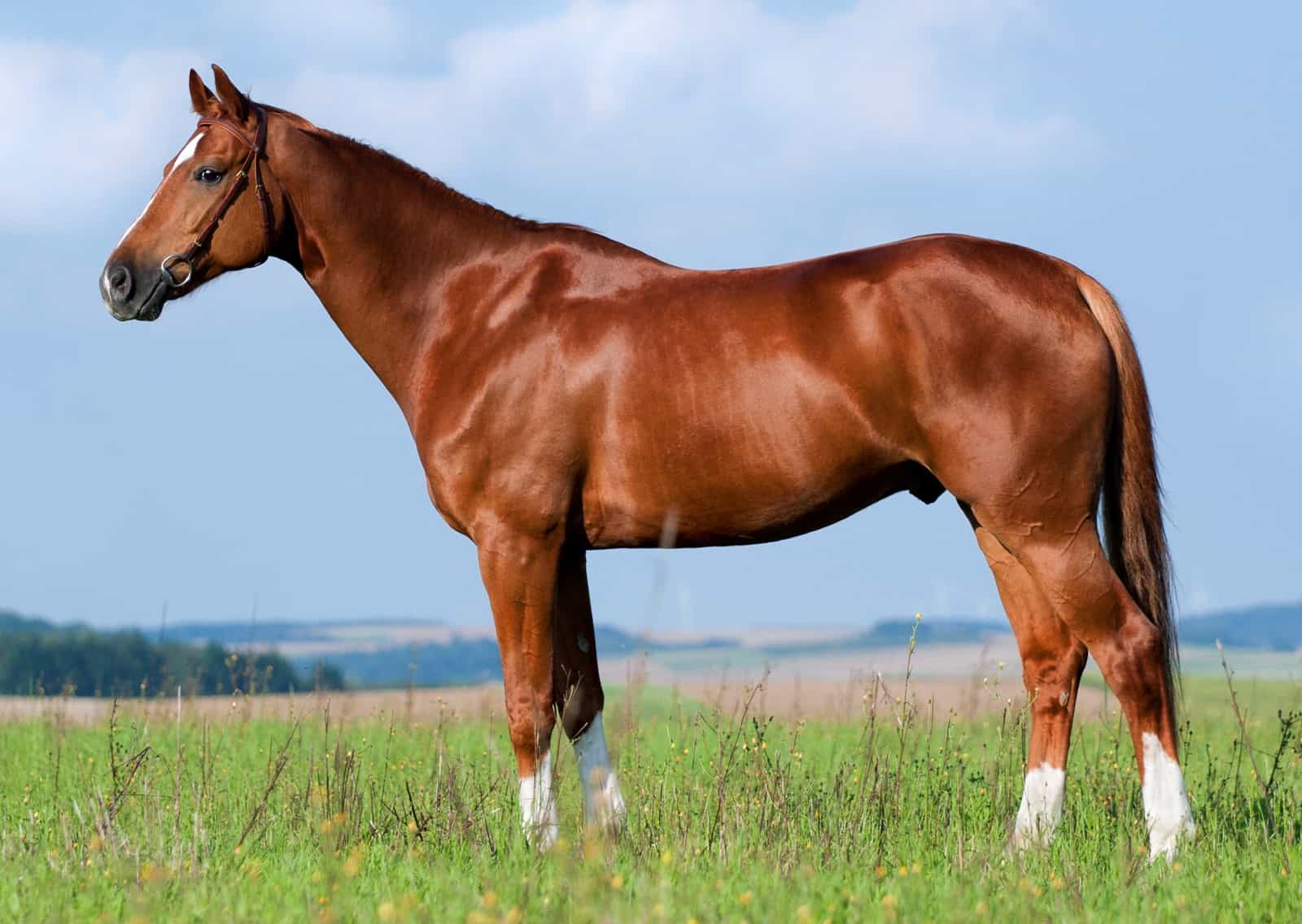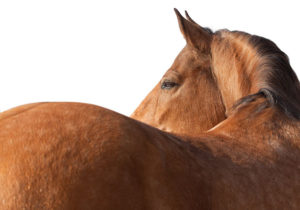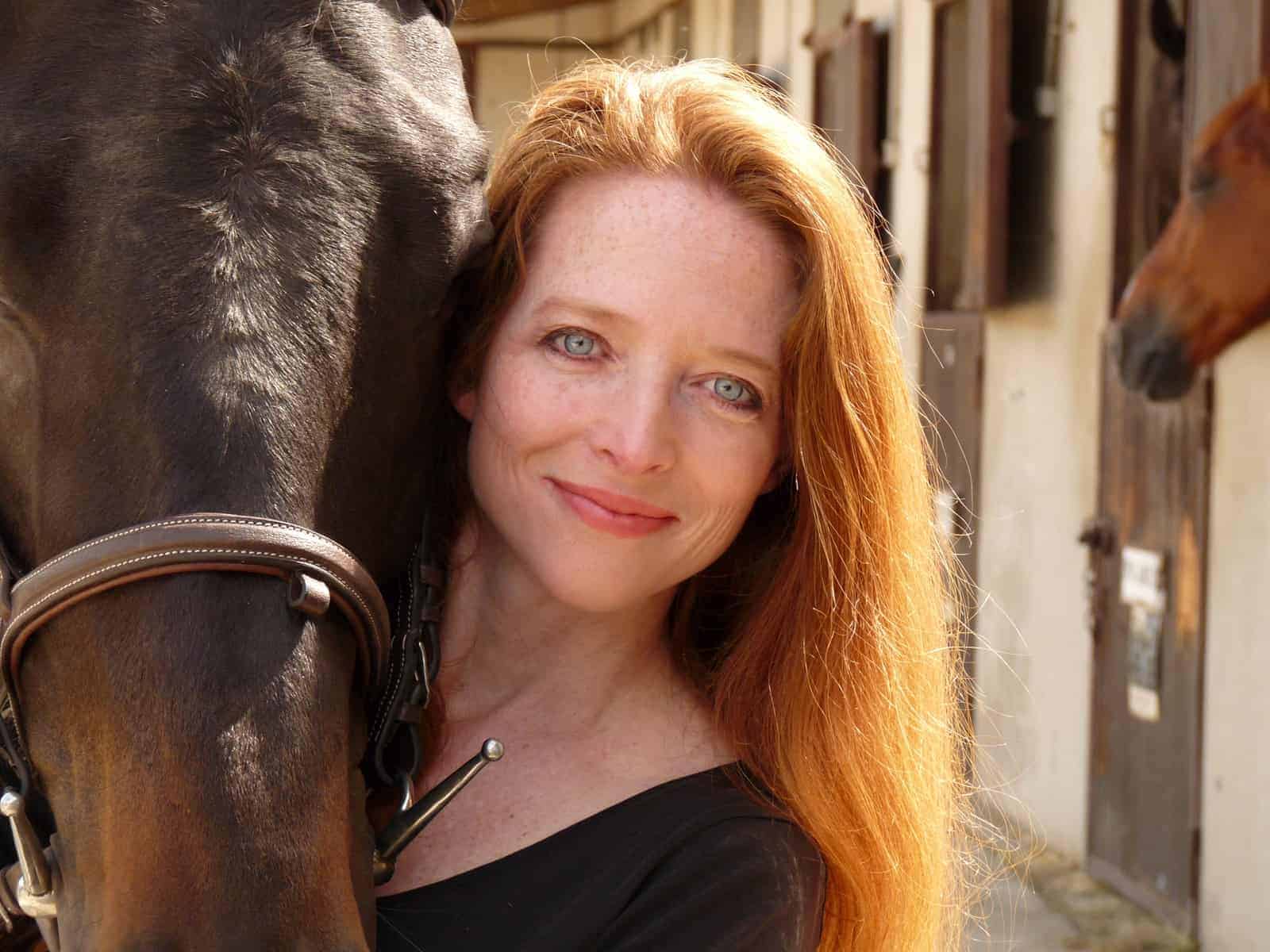Horse Topline-Building Tips

Six ways to transform your horse’s topline from underdeveloped to well-toned
Bettina had a good topline. Her neck and back musculature was even, with no fat lumps. Her neck transitioned smoothly into her shoulders, with no abrupt or angular gaps alongside her withers. Her spine was surrounded by a nice continuum of toned muscles along its length down into the croup.
Then, life happened. I bred my 1,500-pound, 17-hand Warmblood mare, and she had a foal. Then another. Then I loaned her out to a couple of young riders who started her back under saddle doing dressage, jumping, and cross-country. And little by little the problems started. While she took home ribbons at shows, she became grumpy, pinning her ears when she saw riders approaching her stall, snapping while getting girthed up. Eventually she showed subtle signs of lameness, leading to her retirement.
Bettina arrived home fit, strong, lame, and with a prominent ridge spanning from withers to rump. Her vertebral column peaked above everything around it. The top of her croup protruded, and she had gaps beside her withers. At 13 years old Bettina wasn’t starved, wasn’t neglected, and wasn’t unfit. But she, like many other working horses, had a severely undeveloped topline. Her history of foaling, poor saddle fit, possibly inappropriate nutrition, and lameness all contributed.
With proper attention to her needs and a lot of patience, though, I’m seeing Bettina’s lovely look start to come back again. These six steps can help others in the same boat achieve a topline transformation.

Step 1: Ask Why
Horses are genetically programmed to have good toplines. Unless they have an underlying medical issue affecting muscle development or aren’t getting proper nutrition, they’ll develop a nice, smooth topline from neck to tail naturally, says Nicole Rombach, APM, MEEBW, CCBW, PG AM, MSc, PhD, president of Equinenergy/Caninenergy Ltd and chair of the International Equine Body Worker Association for the U.K. and Europe.
Except in malnutrition cases, the main problem horses lacking a topline likely have is a history of poor posture. “It’s the past events that shape the posture of the horse,” Rombach says.
Like humans, horses need good posture when standing and moving to stave off back and neck pain, with their abdominal tunic (which covers the oblique muscles and supports the abdomen) working to help support the back. “If the core stability isn’t there, the back and neck take over to manage that stability, and that’s where things can become painful,” she says.
But before you can build that topline, you first have to figure out why it disappeared in the first place.
Look at the horse’s musculoskeletal history. “Topline issues can develop when some horses are ridden too young, when they’re too weak to carry the rider, because of bad saddle fit, or back or neck problems,” she says.
Lameness is another common culprit. “Lameness and neck/back problems are fairly synonymous,” Rombach says. “They’re not mutually exclusive.”
Horses can also lose their toplines while on stall rest after an injury. This limited movement is “equivalent to bed rest for a human,” Rombach says. That’s also true for sport horses that spend most of their time in stalls. “That muscle mass just gets wasted,” she says. “If you don’t use it, you lose it.”
Foaling, as in Bettina’s case, and colic surgery can also weaken the abdominal muscles. Underlying health conditions can also be to blame, says Clair Thunes, PhD, independent equine nutrition consultant and owner of Summit Equine Nutrition LLC, based in Sacramento, California. Horses with muscle-related diseases such as polysaccharide storage myopathy (PSSM) can have great difficulty building topline, as can older horses that don’t build muscle mass well. And horses with pituitary pars intermedia dysfunction (equine Cushing’s disease) have difficulty metabolizing and using muscle-building proteins as they should.

Step 2: Fix Underlying Issues
Resolving the primary issue behind topline loss allows the horse’s brain to “reset.” Topline muscles don’t strengthen from sweaty workouts but through building core muscles—posture training, essentially. For that to happen, handlers need to train the horse’s mind to know what to do with those muscles, as well as the opposing ones along the abdomen.
“It’s all about synergy between abdominal and deeper core muscles,” Rombach says. “They have to function synergistically with the back, with core dynamic stability. That requires motor control in the brain. So essentially, you have the brain guiding the movement of the different body parts. And the brain needs to know what to do and accept that.”
Work with your veterinarian to diagnose any medical issues your horse might have and determine management options. If pain is to blame, topline-building exercises will only make it worse. “You’ll be unable to change motor patterns in the brain so long as there’s a pain component,” Rombach says, adding that it could even be dangerous. “If you try some topline exercises on a painful horse, that can trigger a pain response that’ll cause defensive behaviors.”
If the primary problem is limited movement, get the horse moving, Rombach says. Let him live outside as much as possible, relocating him to a larger turnout space if necessary.
Finally, if age is the culprit your efforts are best spent re-evaluating his diet (see Step 4).
Step 3: Evaluate Saddle Fit
A saddle can destroy a topline. As long as your saddle is ill-fitting, your horse will adjust and continually readjust his posture in ways to relieve the pain. Over time he’ll develop chronic pain and muscle wasting along the topline.

“We see very fit performance horses, muscled all over with strong hearts and long endurance, but they’ve got poor topline build because their saddle fit is bad,” Thunes says. “And no matter how much tough work and good diet you put into that horse, if the saddle doesn’t fit, you’ll never get good topline.”
Proper saddle fit should start from the beginning of ridden training, says Rombach. Young horses can quickly learn bad posture habits if started under an ill-fitting saddle.
Horses need saddle refitting regularly because back shape evolves with training and age. As the topline improves the saddle can cause uncomfortable pressure points along the new musculature. So during this process, have an independent fitter or saddle company representative evaluate your tack regularly—once a month if you’re building topline or once every six months if your horse’s topline is stable. (Young horses might need evaluations every three months as they continue to grow and round out.) If your saddle is wool-flocked, your fitter can reflock it to adjust the fit.
Step 4: Get a Nutritionist On Board
You can’t build without building blocks. For muscles, the primary building blocks are proteins. And the primary building blocks of proteins are amino acids.
“You need adequate protein but also calories to build muscle and to support the work the horse is doing,” Thunes says.

Protein feeding must be combined with an appropriate exercise regime, however, to have the most effect on topline. If a horse is already getting a diet with adequate protein and a well-balanced amino acid profile, adding more is unlikely to help build topline (Think of it this way: Body builders can’t just sit on the couch eating steak and expect to get bigger muscles).
Many owners overfeed protein, thinking horses need more than they do.
“While I rarely see diets that are deficient in crude protein, I sometimes find that diets are lacking in quality protein,” she says. “The quality is based on the kinds and amounts of amino acids provided by that protein source. Sometimes I see an improvement in topline just by adding a higher-quality protein source, such as soybean meal, to the ration.”
You might want to avoid trying to improve quality on your own, however. Supplementing is an art requiring a delicate balancing act, not just piling on more of a single nutrient.
“People get caught up in the protein thing and start adding single amino acids into the diet, and that’s probably not a good idea,” she says. “You need a balanced amino acid profile in the diet, which means finding high-quality, balanced protein sources.”
Instead, try something far simpler, Thunes says: “Follow the package directions. If people would follow feed instructions properly, half their problems would be solved.”

Most quality commercial feeds result from expert nutritional analyses considering all required nutrients and their balance. But for various reasons, owners ignore the ration recommendations printed on the label.
“They choose a feed that calls for 8 to 9 pounds of serving per day, but they only feed 2 pounds per day because if they feed 9 pounds per day the horse would get fat,” Thunes says. “What that tells me is they haven’t picked the right feed for their horse.”
As a result the horse lacks amino acids and other nutrients, and the topline and abdominal muscles (and probably other tissues, as well) suffer.
Your nutritionist can play a critical role by helping you find the right commercial feed for your particular horse, Thunes says. He or she will consider the horse’s work level, age, breed, personality, size, body condition, various issues, and more.
Evaluate Your Progress
Topline-building can take several weeks to several months. But you don’t have to wait that long to start seeing changes. In the beginning you’ll notice little to no musculature around your horse’s spine, making the back look “sunken in.” He’ll have dips around the withers and a bony croup. His abdomen might hang low and, out of weakness, he’ll stand with his hind legs slightly back and his neck slightly raised.
From time to time, check your horse’s “abdominal lift.” Stand him square and tickle him at the girthline, about midway underneath his belly, with your fingers. He should lift his back slowly and drop his head in response, says Nicole Rombach, APM, MEEBW, CCBW, PG AM, MSc, PhD, president of Equinenergy/Caninenergy Ltd and chair of the International Equine Body Worker Association for the U.K. and Europe. You might even see the gaps around the withers fill in during the effort. With a poor topline he might lift his back up 3 or 4 centimeters.
If your topline-building is working, you’ll see those structures start to round out and the transitions from neck to withers to back to croup become smooth. By the end of the building period, with a good topline, the horse should stand under himself with a tucked tummy. He’ll have no pockets around the shoulder blades or withers and display a “really nice continuum of back muscles and quarter gluteal muscles without a sharp division between the two,” says Rombach. At this point the abdominal lift should only be about 1 centimeter.
Once you’ve reached that point, congratulations! You’ve got a great topline. But your work isn’t finished. Your horse can and should continue to benefit from core training exercises on the ground before every ride and from regular core work under saddle, Rombach says.
—Christa Lesté-Lasserre, MA
“Just because somebody down the barn aisle says they swear by a particular feed doesn’t mean it’s the right one for your horse,” she says. “Check with a nutritionist to get it right, so you can follow the package directions appropriately and get that topline built.”
Sometimes, though, even following the package directions isn’t enough. Especially in horses with underlying disease affecting muscle development, such as type 2 PSSM, targeted protein supplementation can be beneficial.
“Those horses appear to benefit from what’s called ‘branched chain’ amino acids, which I can find in whey protein supplements,” Thunes says. “I recommend those about 30 to 45 minutes after a workout, when they need the protein the most to rebuild the muscle that was damaged during exercise. And that seems to really help them.”
Lastly, make sure your horses eat off the ground and not from high-set feeders, so those stabilizing muscles benefit from “grazing exercise,” Rombach adds.
Step 5: Work on Ground Exercises
Building the back means building the horse’s core. “There’s really no shortcut,” Rombach says. The good news is you can do core training in only 5 minutes a day on the ground.
“The first thing you have to do is build that brain-body connection,” she says. “The muscle control in the brain has to be wired in such a way that the supporting, stabilizing, core musculature fires first, not second.”
You can find a useful series of exercises in Activate Your Horse’s Core: Unmounted Exercises for Dynamic Mobility, Strength & Balance, co-authored by Hilary Clayton, BVMS, PhD, MRCVS, Dipl. ACVSMR, and Narelle Stubbs, PhD, B.AppSc, M.AnimSt. In it they describe ground exercises that strengthen stabilizing muscles in the back and abdomen. Most of the exercises require that the horse stand square, without taking a step, and move his head and neck to different positions.
“The easiest exercises, and the ones I would lead with, are the carrot exercises before work,” Rombach says. In these, owners use a carrot to bring the horse’s head to his sides and between his front legs. (Metabolic horses can benefit from clicker training instead, she adds.)
“It’s important to build up slowly,” she says. “Start by asking the horse to hold it for only two seconds, and over a period of weeks build that up to a 10-second hold in each position.”
Five repetitions of each exercise before riding—not after, when the muscles are tired—make for a great topline-building workout. “That’s a very small investment for a great topline and core strength,” Rombach says.

Step 6: Train the Brain
Under saddle, head for the hills, Rombach says. A good topline exercise in ridden work is going up and down hills—especially down them. Hill work forces the brain to consider the body’s center of gravity and posture, particularly if it has to manage downhill movement slowly, counter to what’s easiest.
“Speed gives you balance,” she says. “The slower you go, the more stabilizing control you need. So when you go more slowly in each gait, you procure that specific muscular activation from the brain to get the stability.”
Riders can also apply elastic resistance bands in the abdominal area and hindquarters during ridden work, she says. The bands stimulate proprioception—self-awareness of where and how an individual’s body parts are being used—which results in the strengthening of core muscles and, hence, the topline.
“There’s constant feedback in motion between the bands and the muscles via the skin, and movement is created, altered, and/or enhanced by stimulation of those muscles,” she says. “With adequate building of the core musculature … you can have a supportive back, instead of a back that has to keep posture and stabilize at the same time.”
Take-Home Message
Your horse’s topline isn’t just a reflection of good breeding and conformation; it’s a reflection of his general musculoskeletal health and comfort. If his topline is poor, you need to rebuild it. Fortunately, most horses lacking a topline can recover.
I’ve been watching Bettina’s back and neck go through some impressive transformations over the past few weeks. And by following our sources’ advice for your horse, you can do the same.

Written by:
Christa Lesté-Lasserre, MA
Related Articles
Stay on top of the most recent Horse Health news with












